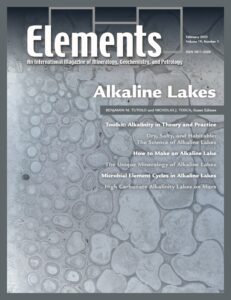Alkaline Lakes
Benjamin M. Tutolo and Nicholas J. Tosca – Guest Editors
Table of Contents
Alkaline lakes are incredibly dynamic, unique, and fascinating biogeochemical environments. This thematic issue will leverage the authors’ multidisciplinary insights to portray alkaline lakes’ biogeochemical, mineralogical, and geological importance for both science and society. The articles will individually explore the unique conditions leading to the formation of alkaline lakes, the distinctively productive microbial ecosystems that inhabit them, their distinguishing chemistry and mineralogy, their role as societally important economic resources, and their potential to have originated life on Earth as well as Mars. This approachable overview of the geochemical, biological, and societal aspects of alkaline lakes will establish their vital importance to the broad readership of Elements and stimulate continued explorations of these mesmerizing geological systems.
- Dry, Salty, and Habitable: The Science of Alkaline Lakes
- How to Make an Alkaline Lake: Fifty Years of Chemical Divides
- Making Salt from Water: The Unique Mineralogy of Alkaline Lakes
- The Vigor, Futility, and Application of Microbial Element Cycles in Alkaline Soda Lakes
- High Carbonate Alkalinity Lakes on Mars and their Potential Role in an Origin of Life Beyond Earth
v19n2 Into the Rift: The Geology of Human Origins in Eastern Africa
Guest Editors: Anatoly N. Zaitsev (St. Petersburg State University, Russia), Charles Musiba (University of Colorado, USA), and Lindsay McHenry (University of WisconsinMilwaukee, USA)
Spanning from the horn of Africa down to Lake Malawi, the East Africa Rift preserves a plethora of paleoanthropological sites (e.g., Olduvai Gorge, Turkana, Awash) that document our evolutionary journey spanning the last seven million years of Earth’s history. A common feature of these sites is that they are associated with volcanicsedimentary basins intimately related to the development of the rift. Radiometric and paleomagnetic geochronology helps establish age relations between different hominin species. Geochemical studies of primary tuffs help correlate between sites and identify specific volcanic sources. Authigenic minerals formed in rift lakes can help reconstruct past climates and environments. Recent excavations at Laetoli show that this valuable site is slowly disappearing owing to diagenetic processes, and preservation of the footprints is essential and urgently needed.
- The Dawn of Humanity: What Can Paleoanthropologists and Geoscientists Learn from One Another? Charles Musiba (University of Colorado, USA), Agness Gidna (Ngorongoro Conservation Area Authority, Tanzania), and Mulugeta Alene (Addis Ababa University, Ethiopia)
- Tectonic and Paleoclimatic Setting for Hominin Evolution in Eastern Africa Lydia Olaka (Technical University of Kenya, Kenya) and Cynthia J. Ebinger (Tulane University, USA)
- Using Radiometric Dating, Magnetostratigraphy, and Tephrostratigraphy to Calibrate Rates of Hominin Evolution in the East African Rift Alan L. Deino (Berkeley Geochronology Center, USA), Luis Gibert (University of Barcelona, Spain), and Céline M. Vidal (University of Cambridge, UK)
- Laetoli: The Oldest Known Hominin Footprints in Volcanic Ash Anatoly N. Zaitsev (St. Petersburg State University, Russia), Anton R. Chakhmouradian (University of Manitoba, Canada), and Charles Musiba (University of Colorado, USA)
- Paleolakes of Eastern Africa: Zeolites, Clay Minerals, and Climate Lindsay J. McHenry (University of WisconsinMilwaukee, USA), Verena Foerster (University of Cologne, Germany), and Daniel Gebregiorgis (Georgia State University, USA)
- Alkaline Lakes (February 2023)
- Into the Rift: The Geology of Human Origins in Eastern Africa (April 2023)
- Olivine (June 2023)
- Biomagnetism (August 2023)
- Large Igneous Provinces: Versatile Drivers of Global Change (October 2023)
- Geometallurgy: Resource Optimization for a Sustainable Future (December 2023)
Thematic Articles
Dry, Salty, and Habitable: The Science of Alkaline Lakes
By Benjamin M. Tutolo and Nicholas J. Tosca

Alkaline lakes are incredibly dynamic, unique, and fascinating biogeochemical environments that have remained distinctive features of Earth’s evolving surface over much of its history. Understanding these evaporative surface waters, their exceptionally productive ecosystems, and their rare sedimentary deposits requires an inherently interdisciplinary approach at the intersection of hydrology, geology, and biology. The discipline-spanning articles in this issue evaluate the diverse characteristics that make these dry, salty, and habitable environments so valuable in unraveling the history and evolution of Earth’s surface, and in following the arc of habitability on ancient Mars. Here, in this introductory article, we summarize the characteristics and importance of alkaline lakes with the hope of attracting you, too, to join in our fascination with them.
How to Make an Alkaline Lake: Fifty Years of Chemical Divides
By Nicholas J. Tosca and Benjamin M. Tutolo
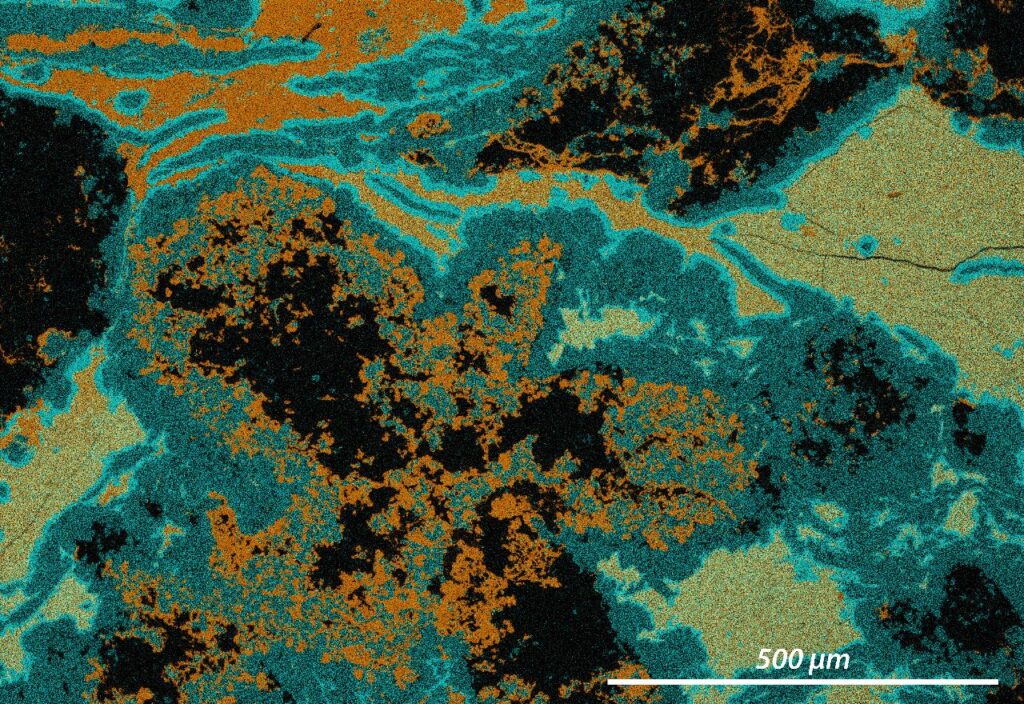
Of all the surface environments on our planet, alkaline lakes are among the most distinctive and significant in terms of their biogeochemistry, climatic sensitivity, and associated mineral deposits. But how does the Earth produce alkaline lakes? Fifty years ago, Lawrence Hardie and Hans Eugster hypothesised that the bewildering complexity of non-marine evaporites could be explained by common successions of mineral precipitation events, or chemical divides. Since that time, the chemical divide concept has provided Earth scientists with an enduring framework within which to integrate new advances in mineral–water equilibria and kinetics, sedimentology, and paleoclimatology. These developments are painting an increasingly detailed picture of how alkaline waters form and interact with magmatic and atmospheric CO2, now and in the distant past.
Making Salt from Water: The Unique Mineralogy of Alkaline Lakes
By Maija J. Raudsepp, Sasha Wilson, and Bree Morgan
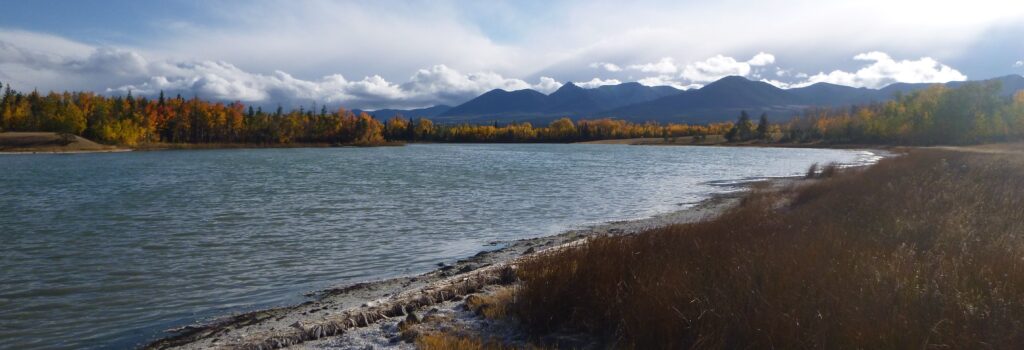
Alkaline lakes have some of the most unique and diverse known mineral assemblages as a result of their very high pH and dissolved inorganic carbon concentrations. In these closed-basin systems, aqueous geochemistry and mineralogy are intimately linked, whereby the removal of elements through mineral precipitation controls the lake water geochemistry. The resulting extreme water chemistry of alkaline lakes produces minerals that are rare in other environments, including low-temperature minerals that record valuable environmental information and that are commonly extracted as mineral resources. Alkaline lakes are also excellent environments to study various processes in mineral crystallization, growth, and transformation, including the formation of metastable phases, precipitation after extreme supersaturation, co-precipitation of minerals, and the influence of dynamic conditions.
The Vigor, Futility, and Application of Microbial Element Cycles in Alkaline Soda Lakes
By Marianne Haines, Varada Khot, and Marc Strous
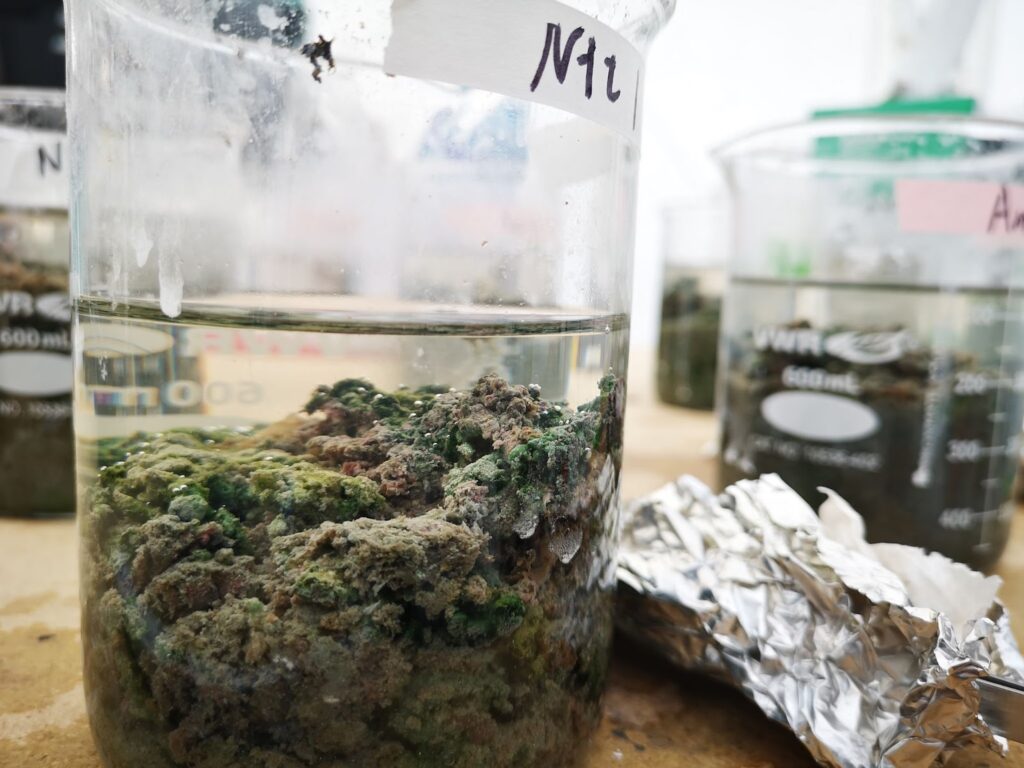
Alkaline soda lakes are known as some of nature’s most biologically productive ecosystems. Vigorous production (photosynthetic conversion of inorganic carbon into biomass) is countered by incremental biomass degradation, which fuels and feeds a diverse microbial community. Learn here about key adaptations that help microbes survive and thrive in the extreme conditions of alkaline soda lakes. Dive into the interconnected microbial element cycles of alkaline soda lakes and discover how the geochemistry of these environments presents microbes with unique challenges and opportunities. Throughout this article, explore how the microbial inhabitants of alkaline soda lakes have been harnessed in biotechnological applications, including the production of protein-rich food, detergent enzymes, and the purification of biogas.
High Carbonate Alkalinity Lakes on Mars and their Potential Role in an Origin of Life Beyond Earth
By Joel A. Hurowitz, David C. Catling, and Woodward W. Fischer
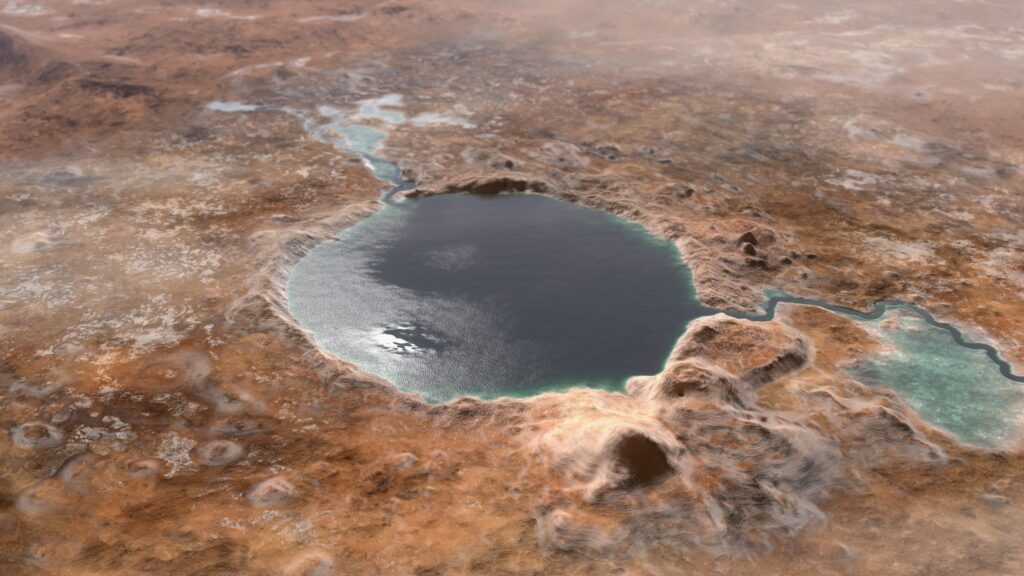
The exploration of Mars has revealed that its ancient surface hosted lakes with a dazzling array of chemical and physical conditions and processes. The potential habitability of surface waters has driven studies aimed at understanding whether or not Mars once hosted life. High levels of atmospheric carbon dioxide are probable on early Mars, which means that lakes derived from weathering fluids could have contained substantial carbonate alkalinity. Recent studies show that lakes with high carbonate alkalinity are able to concentrate the phosphate and cyanide that are critical for molecular synthesis in the origin of life. While evidence for carbonate-rich Martian lakes remains limited, NASA’s Perseverance rover may reveal clues about the past existence of such waters in Jezero Crater.



